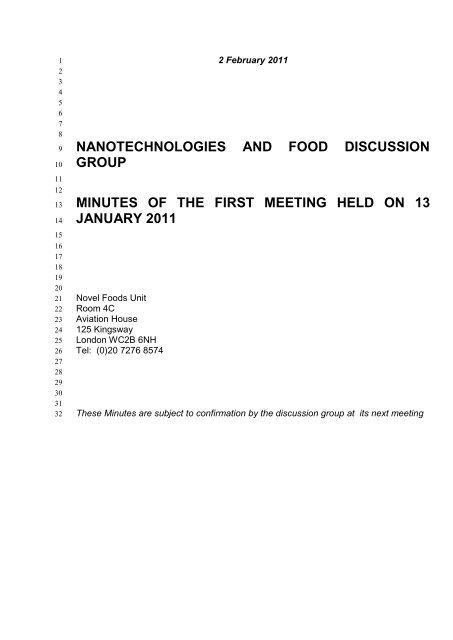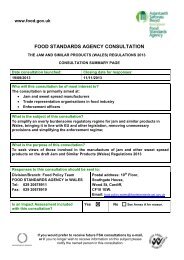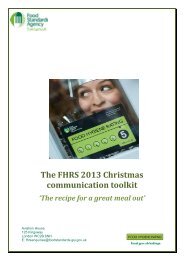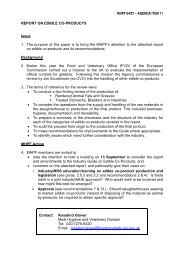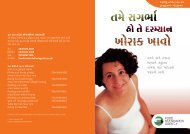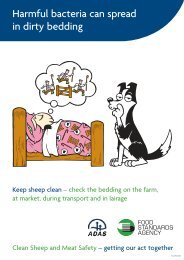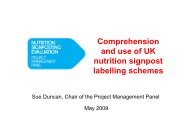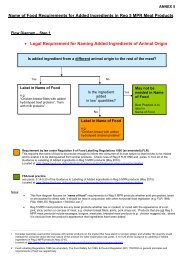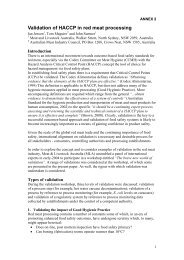nanotechnologies and food discussion group minutes of the first
nanotechnologies and food discussion group minutes of the first
nanotechnologies and food discussion group minutes of the first
Create successful ePaper yourself
Turn your PDF publications into a flip-book with our unique Google optimized e-Paper software.
1<br />
2<br />
3<br />
4<br />
5<br />
6<br />
7<br />
8<br />
9<br />
10<br />
11<br />
12<br />
13<br />
14<br />
15<br />
16<br />
17<br />
18<br />
19<br />
20<br />
21<br />
22<br />
23<br />
24<br />
25<br />
26<br />
27<br />
28<br />
29<br />
30<br />
31<br />
32<br />
2 February 2011<br />
NANOTECHNOLOGIES<br />
GROUP<br />
AND FOOD DISCUSSION<br />
MINUTES OF THE FIRST MEETING HELD ON 13<br />
JANUARY 2011<br />
Novel Foods Unit<br />
Room 4C<br />
Aviation House<br />
125 Kingsway<br />
London WC2B 6NH<br />
Tel: (0)20 7276 8574<br />
These Minutes are subject to confirmation by <strong>the</strong> <strong>discussion</strong> <strong>group</strong> at its next meeting
1<br />
2<br />
3<br />
4<br />
5<br />
6<br />
7<br />
8<br />
9<br />
10<br />
11<br />
12<br />
13<br />
14<br />
15<br />
16<br />
17<br />
18<br />
19<br />
20<br />
21<br />
22<br />
23<br />
24<br />
25<br />
26<br />
27<br />
28<br />
29<br />
30<br />
31<br />
32<br />
33<br />
34<br />
35<br />
36<br />
MINUTES OF THE FIRST MEETING OF THE NANOTECHNOLOGIES AND FODO<br />
DISCUSSION GROUP, HELD ON 13 JANUARY 2011 IN CONFERENCE ROOM 4,<br />
AVIATION HOUSE.<br />
Chair: Terry Donohoe (Head <strong>of</strong> Chemical Safety Division, FSA)<br />
Present<br />
Katy Berry (GO-Science)<br />
Dean Burfoot (Campden BRI)<br />
Qasim Chaudhry (FERA)<br />
Kenneth Chinyama (FDF)<br />
Sue Davies (Which?)<br />
Wendy Dixon (Food Additives Branch, FSA)<br />
Sylvia Gaysinksky (BEMA)<br />
David Gott (Chemical Risk Assessment Unit, FSA)<br />
Jonathan Graves (DoH)<br />
Kathy Groves (Lea<strong>the</strong>rhead Food Research)<br />
Nigel Harrison (Defra)<br />
Stephen Johnson (Food Additives Branch, FSA)<br />
Andrew Kendrick (FAIA)<br />
Nick Kernoghan (Pira International)<br />
S<strong>and</strong>y Lawrie (Novel Foods Unit, FSA)<br />
Micah McGuire (Consumer Engagement Branch, FSA)<br />
Andrew Opie (BRC)<br />
Ed Potter (Food Contact Materials Branch, FSA)<br />
Manisha Upadhyay (Novel Foods Unit, FSA)<br />
Apologies<br />
Gill Smith (HSE)<br />
Chris Dale (BASF)<br />
Mike Butler (Unilever)<br />
1. Welcome <strong>and</strong> Introductions<br />
The Chairman introduced himself <strong>and</strong> welcomed members to <strong>the</strong> <strong>group</strong>. Members<br />
briefly introduced <strong>the</strong>mselves <strong>and</strong> explained <strong>the</strong>ir interest in <strong>nanotechnologies</strong> <strong>and</strong><br />
<strong>food</strong>.<br />
2
1<br />
2<br />
3<br />
4<br />
5<br />
6<br />
7<br />
8<br />
9<br />
10<br />
11<br />
12<br />
13<br />
14<br />
15<br />
16<br />
17<br />
18<br />
19<br />
20<br />
21<br />
22<br />
23<br />
24<br />
25<br />
26<br />
27<br />
28<br />
29<br />
30<br />
31<br />
32<br />
33<br />
34<br />
35<br />
36<br />
37<br />
38<br />
39<br />
40<br />
41<br />
42<br />
43<br />
44<br />
45<br />
2. Purpose <strong>of</strong> <strong>the</strong> <strong>group</strong><br />
The FSA gave a short presentation, outlining <strong>the</strong> main Agency specific<br />
recommendations from <strong>the</strong> House <strong>of</strong> Lords report into <strong>nanotechnologies</strong> <strong>and</strong> <strong>food</strong>. The<br />
setting up <strong>of</strong> this <strong>discussion</strong> <strong>group</strong> stemmed from a recommendation from <strong>the</strong> House <strong>of</strong><br />
Lords <strong>and</strong> it was intended that <strong>the</strong> <strong>group</strong> will enable information to be exchanged<br />
between different sectors in <strong>the</strong> <strong>nanotechnologies</strong> <strong>and</strong> <strong>food</strong> area in addition to helping<br />
<strong>the</strong> FSA take forward some <strong>of</strong> <strong>the</strong> recommendations from <strong>the</strong> House <strong>of</strong> Lords report.<br />
3. Updates from <strong>the</strong> FSA<br />
Novel Foods<br />
The FSA explained <strong>the</strong> main regulatory developments in <strong>the</strong> Novel Foods area.<br />
Relating to <strong>the</strong> proposal to amend <strong>the</strong> Novel Foods Regulation, <strong>the</strong> common position <strong>of</strong><br />
Member States was adopted in March 2010 <strong>and</strong> this made explicit that any<br />
nanomaterial not used before 15 May 1997 would need assessment as a novel <strong>food</strong>.<br />
Following this, <strong>the</strong> European Parliament proposed 103 amendments on second<br />
reading. There were however no new amendments relating to engineered<br />
nanomaterials. The FSA explained that <strong>the</strong> proposal will undergo formal conciliation in<br />
February/March 2011 <strong>and</strong> if agreed <strong>the</strong> new regulation might be adopted in June 2011<br />
<strong>and</strong> come fully into effect in June 2013.<br />
The FSA outlined <strong>the</strong> definition <strong>of</strong> engineered nanomaterial proposed in <strong>the</strong> amended<br />
novel <strong>food</strong> regulation proposal <strong>and</strong> explained <strong>the</strong> potential difficulties relating to this in<br />
terms <strong>of</strong> a lack <strong>of</strong> suitable methods to detect <strong>and</strong> measure nanoparticles in <strong>food</strong> <strong>and</strong><br />
<strong>the</strong>refore potential difficulties relating to enforcement. None<strong>the</strong>less, <strong>the</strong> definition does<br />
have <strong>the</strong> capacity to be adapted relatively easily as science progresses. In terms <strong>of</strong> <strong>the</strong><br />
Novel Foods Regulation, <strong>the</strong> FSA considers that a definition acts merely as a safety net<br />
as <strong>food</strong>s produced through <strong>nanotechnologies</strong> will be caught by <strong>the</strong> scope <strong>of</strong> <strong>the</strong><br />
regulation ei<strong>the</strong>r because <strong>the</strong>y are novel or because <strong>the</strong>y are produced using a new<br />
production process.<br />
The FSA informed <strong>the</strong> <strong>group</strong> that in October 2010, DG SANCO issued a draft generic<br />
definition <strong>of</strong> “nanomaterial” drawing on advice from SCENIHR (<strong>the</strong> EU scientific<br />
committee on emerging <strong>and</strong> newly identified health risks) which went out to<br />
consultation. UK Government Departments responded to this consultation by raising a<br />
number <strong>of</strong> questions relating to limitations in current measurement techniques, <strong>the</strong><br />
possibility that existing materials which contain a very small proportion <strong>of</strong> a nanoscaled<br />
element may be unnecessarily classed as nanomaterials, <strong>and</strong> <strong>the</strong> lower size limit <strong>of</strong><br />
1nm.<br />
Food additives <strong>and</strong> <strong>food</strong> contact materials<br />
There were no new developments since <strong>the</strong> publication <strong>of</strong> <strong>the</strong> House <strong>of</strong> Lords report,<br />
except that <strong>the</strong> revised framework for <strong>the</strong> regulation <strong>of</strong> <strong>food</strong> additives came into effect in<br />
January 2010 <strong>and</strong> <strong>the</strong> draft legislation on plastic <strong>food</strong> contact materials was near to<br />
being formally adopted.<br />
3
1<br />
2<br />
3<br />
4<br />
5<br />
6<br />
7<br />
8<br />
9<br />
10<br />
11<br />
12<br />
13<br />
14<br />
15<br />
16<br />
17<br />
18<br />
19<br />
20<br />
21<br />
22<br />
23<br />
24<br />
25<br />
26<br />
27<br />
28<br />
29<br />
30<br />
31<br />
32<br />
33<br />
34<br />
35<br />
36<br />
37<br />
38<br />
39<br />
40<br />
41<br />
42<br />
43<br />
44<br />
45<br />
46<br />
47<br />
48<br />
49<br />
Consumer Engagement<br />
The FSA explained to <strong>the</strong> <strong>group</strong> that a series <strong>of</strong> <strong>nanotechnologies</strong> <strong>and</strong> <strong>food</strong> citizens<br />
forums had been taking place since November 2010. The forums have been organised<br />
by <strong>the</strong> FSA <strong>and</strong> TNS/BMRB as a tool to discuss policy work with consumers <strong>and</strong><br />
examine awareness <strong>and</strong> attitudes towards <strong>nanotechnologies</strong> <strong>and</strong> <strong>food</strong>. The forums are<br />
designed very much to gain a qualitative insight into consumer attitudes towards<br />
<strong>nanotechnologies</strong> ra<strong>the</strong>r than to produce hard statistics. The forums involved one<br />
hundred people in Engl<strong>and</strong>, <strong>and</strong> Scotl<strong>and</strong>. Participants were recruited to reflect a mix <strong>of</strong><br />
race, age <strong>and</strong> socioeconomic backgrounds <strong>and</strong> are being conducted in three waves<br />
(waves one <strong>and</strong> two are complete <strong>and</strong> wave three will take place in January/February).<br />
Most people had never heard <strong>of</strong> <strong>nanotechnologies</strong> in relation to <strong>food</strong> but were more<br />
aware <strong>of</strong> its use for o<strong>the</strong>r areas <strong>of</strong> technology e.g. nano iPods.<br />
Consumers were interested to know why <strong>nanotechnologies</strong> are needed in <strong>food</strong> uses<br />
<strong>and</strong> were better able to appreciate <strong>the</strong> potential benefits <strong>of</strong> <strong>nanotechnologies</strong> in relation<br />
to <strong>food</strong> packaging than <strong>food</strong> itself. They were concerned about safety aspects <strong>of</strong><br />
<strong>nanotechnologies</strong>, particularly <strong>the</strong> long-term safety, <strong>and</strong> about <strong>the</strong> environmental<br />
impact in relation to <strong>food</strong> packaging e.g. <strong>the</strong> use <strong>of</strong> plastic beer bottles with nanoclay<br />
embedded in <strong>the</strong> plastic as a means <strong>of</strong> preventing beer spoilage.<br />
The final wave <strong>of</strong> this research will look at what ethical issues <strong>the</strong>re may be <strong>and</strong> any<br />
wider implications that need to be considered. Consumers will <strong>the</strong>n be in a better<br />
position to provide a more reasoned argument about <strong>the</strong>ir views. It is expected that <strong>the</strong><br />
TNS/BMRB report on <strong>the</strong>se forums will be published by mid March <strong>and</strong> <strong>the</strong> FSA will<br />
enquire whe<strong>the</strong>r a representative is available to give a presentation at <strong>the</strong> next<br />
<strong>discussion</strong> <strong>group</strong> meeting.<br />
Action: FSA to ask TNS/BMRB to give a presentation to <strong>the</strong> <strong>discussion</strong> <strong>group</strong>.<br />
EFSA’s guidance on <strong>the</strong> risk assessment <strong>of</strong> applications <strong>of</strong> nanoscience <strong>and</strong><br />
<strong>nanotechnologies</strong> to <strong>food</strong> <strong>and</strong> feed.<br />
The FSA mentioned to <strong>the</strong> <strong>group</strong> that at <strong>the</strong> request <strong>of</strong> <strong>the</strong> European Commission,<br />
EFSA’s Scientific Committee was producing practical guidance on <strong>the</strong> risk assessment<br />
<strong>of</strong> applications <strong>of</strong> nanoscience <strong>and</strong> <strong>nanotechnologies</strong> to <strong>food</strong> <strong>and</strong> feed. The Scientific<br />
Committee’s drafting <strong>group</strong> had prepared this draft guidance which was shortly<br />
expected to go out to public consultation. This guidance builds on EFSA’s previous<br />
opinion on <strong>nanotechnologies</strong> <strong>and</strong> <strong>food</strong> published in 2009, but is a more practical <strong>and</strong><br />
pragmatic document aimed at risk assessors <strong>and</strong> applicants. The guidance details <strong>the</strong><br />
approaches to risk assessment <strong>and</strong> appropriate testing methods to be used depending<br />
on:<br />
a. Whe<strong>the</strong>r a material is nano or not<br />
b. If <strong>the</strong>re is exposure to <strong>the</strong> nanomaterial e.g. migration into <strong>food</strong>.<br />
c. If <strong>the</strong> nan<strong>of</strong>orm has an already approved non nan<strong>of</strong>orm <strong>of</strong> <strong>the</strong> material.<br />
d. If <strong>the</strong> nan<strong>of</strong>orm does not have an already approved nan<strong>of</strong>orm <strong>of</strong> <strong>the</strong> material.<br />
To note: EFSA’s draft guidance was published on 14 January 2011 for public<br />
consultation.<br />
4
1<br />
2<br />
3<br />
4<br />
5<br />
6<br />
7<br />
8<br />
9<br />
10<br />
11<br />
12<br />
13<br />
14<br />
15<br />
16<br />
17<br />
18<br />
19<br />
20<br />
21<br />
22<br />
23<br />
24<br />
25<br />
26<br />
27<br />
28<br />
29<br />
30<br />
31<br />
32<br />
33<br />
34<br />
35<br />
36<br />
37<br />
38<br />
39<br />
40<br />
41<br />
42<br />
43<br />
44<br />
45<br />
4. Updates from o<strong>the</strong>r Members<br />
Which?<br />
Which? informed <strong>the</strong> <strong>group</strong> <strong>of</strong> consumer research it had carried out in May 2010 which<br />
included <strong>the</strong> general tracking <strong>of</strong> consumer awareness <strong>of</strong> <strong>nanotechnologies</strong>. Only 37%<br />
had heard <strong>of</strong> <strong>nanotechnologies</strong> <strong>and</strong> most people were aware mostly <strong>of</strong> technology type<br />
applications, only 8% were aware <strong>of</strong> possible <strong>food</strong> applications. Which? reported on a<br />
FAO conference which took place in June 2010 (<strong>the</strong> international conference on <strong>food</strong><br />
<strong>and</strong> agriculture applications <strong>of</strong> <strong>nanotechnologies</strong>) <strong>and</strong> mentioned that a substantial<br />
amount <strong>of</strong> <strong>nanotechnologies</strong> research in <strong>the</strong> <strong>food</strong> area appears to be taking place in S.<br />
America compared to <strong>the</strong> EU. Details <strong>of</strong> <strong>the</strong> conference can be found at<br />
http://www.nanoagri2010.com/<br />
Which? was interested to know how closely <strong>the</strong> UK Government is working with o<strong>the</strong>r<br />
Governments in this area.<br />
Food <strong>and</strong> Drink Federation<br />
FDF informed <strong>the</strong> <strong>group</strong> that it had been disappointed by <strong>the</strong> way <strong>the</strong> House <strong>of</strong> Lords<br />
report was launched in that <strong>the</strong> press release criticised industry for not being<br />
transparent about its research interests, picking this out as <strong>the</strong> key point. This<br />
distracted from <strong>the</strong> body <strong>of</strong> <strong>the</strong> report, which was both reasonable <strong>and</strong> informative.<br />
FDF held a meeting <strong>of</strong> interested members from both scientific <strong>and</strong> public affairs<br />
perspectives in February 2010 to consider <strong>the</strong> report, reactions to it, <strong>and</strong> how FDF<br />
would respond to future developments. Some <strong>of</strong> <strong>the</strong> key findings <strong>of</strong> this meeting were:<br />
Some companies are engaging in research into applications <strong>of</strong><br />
<strong>nanotechnologies</strong>, including <strong>the</strong> use <strong>of</strong> nanoscience to achieve a better<br />
underst<strong>and</strong>ing <strong>of</strong> <strong>food</strong> technology <strong>and</strong> enhance <strong>the</strong> ability to manipulate<br />
ingredients <strong>and</strong> <strong>the</strong> constituent properties <strong>of</strong> <strong>the</strong> <strong>food</strong>. This does not imply <strong>the</strong><br />
use <strong>of</strong> engineered nanoparticles.<br />
Research projects with <strong>the</strong> potential to lead to new product developments are by<br />
<strong>the</strong>ir nature competitive <strong>and</strong> confidential so cannot be placed in <strong>the</strong> public<br />
domain.<br />
Members <strong>of</strong> <strong>the</strong> Select Committee appeared to have an unrealistic expectation<br />
<strong>of</strong> research into nanotechnology applications in <strong>food</strong> in <strong>the</strong> UK <strong>and</strong> may have<br />
interpreted lack <strong>of</strong> reported research as a lack <strong>of</strong> transparency.<br />
Companies are being approached by suppliers <strong>of</strong>fering products <strong>of</strong><br />
nanotechnology, but are not yet using <strong>the</strong>m in <strong>the</strong> EU. Some applications may,<br />
however, be <strong>of</strong> future interest.<br />
In terms <strong>of</strong> <strong>the</strong> perception that industry was already placing products <strong>of</strong><br />
<strong>nanotechnologies</strong> on <strong>the</strong> EU market without declaring <strong>the</strong>ir use, members<br />
suggested that it should be made clear that <strong>the</strong> EU regulatory regime prevents<br />
manufacturers from placing products using <strong>nanotechnologies</strong> on <strong>the</strong> market until<br />
<strong>the</strong>y have been positively assessed by EFSA.<br />
Members reviewed a paper setting out FDF’s activities <strong>and</strong> engagement on<br />
<strong>nanotechnologies</strong> to date <strong>and</strong> supported <strong>the</strong> level <strong>of</strong> activity.<br />
5
1<br />
2<br />
3<br />
4<br />
5<br />
6<br />
7<br />
8<br />
9<br />
10<br />
11<br />
12<br />
13<br />
14<br />
15<br />
16<br />
17<br />
18<br />
19<br />
20<br />
21<br />
22<br />
23<br />
24<br />
25<br />
26<br />
27<br />
28<br />
29<br />
30<br />
31<br />
32<br />
33<br />
34<br />
35<br />
36<br />
37<br />
38<br />
39<br />
40<br />
41<br />
42<br />
43<br />
44<br />
FDF also informed <strong>the</strong> <strong>group</strong> that it held a meeting with Lord Krebs in May 2010<br />
specifically to discuss <strong>the</strong> Select Committee’s report. FDF has continued to engage<br />
with key stakeholders <strong>and</strong> has focused on encouraging <strong>the</strong> development <strong>of</strong> a strong<br />
regulatory framework for <strong>nanotechnologies</strong> <strong>and</strong> <strong>food</strong>.<br />
Lea<strong>the</strong>rhead Food Research (LFR)<br />
LFR informed <strong>the</strong> <strong>group</strong> that <strong>the</strong>re has not been much movement from industry in <strong>the</strong><br />
<strong>nanotechnologies</strong> area, possibly due to concern about public reaction. There has also<br />
been concern from industry about implications <strong>of</strong> possible changes to legislation that<br />
may unnecessarily have an impact on “non-nano <strong>food</strong>s”. Industry recognises <strong>the</strong> need<br />
to increase consumer awareness about <strong>food</strong> manufacture <strong>and</strong> <strong>nanotechnologies</strong> <strong>and</strong><br />
awareness <strong>of</strong> <strong>the</strong> difference between natural <strong>and</strong> engineered nanomaterials. LFR has<br />
collaborated with NanoKTN <strong>and</strong> NanoCentral to run four workshops:<br />
1. Nanocoatings <strong>and</strong> <strong>food</strong> contact materials (8 June 2010)<br />
2. Nanotechnology in Foods: Advances in Ingredient Functionality, 15 September<br />
2010.<br />
3. House <strong>of</strong> Lords report one year on (19 January 2011)<br />
4. Enhancing <strong>the</strong> Health <strong>and</strong> Nutritional Benefits <strong>of</strong> Food Products through<br />
Nanotechnology (2 March 2011).<br />
Labelling <strong>of</strong> <strong>food</strong>s produced using <strong>nanotechnologies</strong><br />
Defra informed <strong>the</strong> <strong>group</strong> that <strong>the</strong> Food Information Regulation (FIR) is being<br />
developed in Brussels <strong>and</strong> this will replace <strong>and</strong> update existing EU legislation on <strong>food</strong><br />
labelling. The European Parliament has proposed a series <strong>of</strong> amendments including a<br />
requirement for engineered nanomaterials to be highlighted as ingredients on <strong>food</strong><br />
labels, <strong>and</strong> this has been accepted by Member States. The next stage is for <strong>the</strong><br />
amended proposal to go through second reading by <strong>the</strong> European Parliament. Defra<br />
highlighted that any proposal to label engineered nanomaterials is dependent on<br />
having an agreed definition.<br />
Which? supported labelling <strong>of</strong> nano ingredients in <strong>food</strong>s in <strong>the</strong> ingredients list which<br />
should not be perceived as a warning to consumers but ra<strong>the</strong>r as a means to allow<br />
consumers to make informed choices relating to <strong>food</strong>, backed up with broader<br />
consumer information Which? also mentioned that <strong>the</strong>re is a need for openness relating<br />
to nano-<strong>food</strong> applications to avoid labelling being discussed as an abstract issue with<br />
no relevance to real products.<br />
The <strong>group</strong> generally agreed that a distinction needs to be made between engineered<br />
<strong>and</strong> naturally occurring nanomaterials <strong>and</strong> highlighted that <strong>the</strong> labelling should only be<br />
required for <strong>the</strong> former.<br />
6
1<br />
2<br />
3<br />
4<br />
5<br />
6<br />
7<br />
8<br />
9<br />
10<br />
11<br />
12<br />
13<br />
14<br />
15<br />
16<br />
17<br />
18<br />
19<br />
20<br />
21<br />
22<br />
23<br />
24<br />
25<br />
26<br />
27<br />
28<br />
29<br />
30<br />
31<br />
32<br />
33<br />
34<br />
35<br />
36<br />
37<br />
38<br />
39<br />
40<br />
41<br />
42<br />
43<br />
44<br />
45<br />
46<br />
5. Taking forward specific recommendations from <strong>the</strong> House <strong>of</strong> Lords Report<br />
Confidential database <strong>of</strong> research being carried out by industry (recommendation<br />
10)<br />
The FSA introduced this item prior to <strong>group</strong> <strong>discussion</strong>. This was <strong>the</strong> only<br />
recommendation in <strong>the</strong> report <strong>the</strong> Agency did not fully accept. While <strong>the</strong> FSA<br />
recognized <strong>the</strong> importance <strong>of</strong> ga<strong>the</strong>ring intelligence about future developments to<br />
identify <strong>and</strong> respond to emerging risks, it did not feel that <strong>the</strong> m<strong>and</strong>atory approach was<br />
<strong>the</strong> best way to take this recommendation forward. The FSA Board had agreed that this<br />
recommendation would be taken forward by way <strong>of</strong> an intelligence ga<strong>the</strong>ring scheme<br />
for nanomaterials in general ra<strong>the</strong>r than by way <strong>of</strong> a database. The Government<br />
response to <strong>the</strong> House <strong>of</strong> Lords <strong>and</strong> <strong>the</strong> UK <strong>nanotechnologies</strong> strategy indicated that<br />
this recommendation would be taken forward in collaboration with o<strong>the</strong>r Government<br />
Departments but <strong>the</strong> extent to which <strong>the</strong> collaboration would take place could not be<br />
confirmed as <strong>the</strong> position <strong>of</strong> <strong>the</strong> new Government on <strong>the</strong> UK <strong>nanotechnologies</strong> strategy<br />
has not yet been confirmed.<br />
The <strong>group</strong> discussed various options for taking forward this recommendation. Fera<br />
highlighted that lessons need to be drawn from Defra’s voluntary reporting scheme for<br />
nanomaterials that received only 13 submissions.. Which? would prefer a m<strong>and</strong>atory<br />
scheme. The FSA explained that <strong>the</strong> previous Government had rejected <strong>the</strong> idea <strong>of</strong> a<br />
m<strong>and</strong>atory scheme, which would require a new legislative framework.<br />
Some members <strong>of</strong> <strong>the</strong> <strong>group</strong> by <strong>and</strong> large preferred <strong>the</strong> use <strong>of</strong> <strong>the</strong> term “horizon<br />
scanning” ra<strong>the</strong>r than “intelligence ga<strong>the</strong>ring’. Information on research should not be<br />
restricted soley to <strong>the</strong> UK, although <strong>the</strong>re could be difficulties in ga<strong>the</strong>ring information<br />
from outside <strong>the</strong> EU.<br />
LFR suggested that <strong>the</strong> FSA could meet confidentially with key players in <strong>the</strong> nano <strong>and</strong><br />
<strong>food</strong> research sector as a way <strong>of</strong> gaining fur<strong>the</strong>r underst<strong>and</strong>ing <strong>of</strong> activities in this area.<br />
The <strong>group</strong> discussed confidentiality, noting that <strong>the</strong> FSA is a public body that is subject<br />
to Freedom <strong>of</strong> Information. Some suggested that possible approaches might be for <strong>the</strong><br />
FSA to enter into non-disclosure agreements, or to produce a formal note outlining <strong>the</strong><br />
Agency’s obligations in terms <strong>of</strong> confidentiality.<br />
(Action: FSA to check <strong>the</strong> feasibility <strong>of</strong> <strong>the</strong>se approaches).<br />
There was a <strong>discussion</strong> on whe<strong>the</strong>r <strong>the</strong> FSA is <strong>the</strong> best organisation to take forward<br />
this recommendation. LFR suggested that in order to encourage participation <strong>of</strong><br />
industry in such a scheme, <strong>the</strong> benefits for industry need to be clearly set out as does<br />
<strong>the</strong> purpose <strong>of</strong> such a scheme <strong>and</strong> what <strong>the</strong> Agency will do with any ga<strong>the</strong>red<br />
information. Which? enquired whe<strong>the</strong>r <strong>the</strong> FSA is intending to approach specific<br />
sectors e.g. <strong>the</strong> supplements industry.<br />
The FSA agreed to draw up a more concrete proposal to take forward this<br />
recommendation, for <strong>discussion</strong> at <strong>the</strong> next meeting <strong>of</strong> <strong>the</strong> <strong>group</strong>.<br />
(Action: FSA to draw up a proposal to take forward this recommendation).<br />
7
1<br />
2<br />
3<br />
4<br />
5<br />
6<br />
7<br />
8<br />
9<br />
10<br />
11<br />
12<br />
13<br />
14<br />
15<br />
16<br />
17<br />
18<br />
19<br />
20<br />
21<br />
22<br />
23<br />
24<br />
25<br />
26<br />
27<br />
28<br />
29<br />
30<br />
31<br />
32<br />
33<br />
34<br />
35<br />
36<br />
37<br />
38<br />
39<br />
40<br />
41<br />
42<br />
43<br />
44<br />
Register <strong>of</strong> nano-<strong>food</strong>s, additives <strong>and</strong> <strong>food</strong> contact materials that have been<br />
approved by EFSA (recommendation 26)<br />
The FSA introduced this item prior to <strong>group</strong> <strong>discussion</strong>. The FSA explained that as<br />
mentioned in <strong>the</strong> Government response, <strong>the</strong> Agency accepted this recommendation but<br />
<strong>the</strong> register could also include products that may be classed as nano for various<br />
reasons e.g. products that may fall within a grey area.<br />
The <strong>group</strong> agreed it should be determined <strong>first</strong> <strong>and</strong> foremost what <strong>the</strong> purpose was <strong>and</strong><br />
who <strong>the</strong> list was intended for.. The <strong>group</strong> discussed whe<strong>the</strong>r <strong>the</strong> register should simply<br />
be a list or a more general source <strong>of</strong> information, e.g. <strong>the</strong> nature <strong>of</strong> <strong>the</strong> nanomaterial,<br />
where is it found, what is it used for, how long has it been used etc.. It was suggested<br />
that <strong>the</strong> list should focus on engineered nanomaterials.<br />
Some <strong>of</strong> <strong>the</strong> <strong>group</strong> questioned whe<strong>the</strong>r such a list was still necessary given <strong>the</strong><br />
amended FIR proposal which, if adopted, will result in engineered nanomaterials being<br />
indicated on ingredient lists. Some members <strong>of</strong> <strong>the</strong> <strong>group</strong> questioned <strong>the</strong> term “nano<strong>food</strong>s”<br />
pointing out that <strong>the</strong> issue is about <strong>food</strong>s containing nanomaterials. Any register<br />
would <strong>the</strong>refore be ano<strong>the</strong>r version <strong>of</strong> EFSA’s approved list which may have gone<br />
through <strong>the</strong> novel <strong>food</strong>s process hence an unnecessary duplication <strong>and</strong> use <strong>of</strong><br />
resources.<br />
The FSA said it would draw up a more concrete proposal on taking forward this<br />
recommendation based on <strong>the</strong> <strong>group</strong>’s ideas for <strong>discussion</strong> at <strong>the</strong> next meeting.<br />
AOB<br />
Action: FSA to draw up a more concrete proposal to take forward this<br />
recommendation.<br />
Group membership: The FSA asked <strong>the</strong> <strong>group</strong> any additional representation was<br />
required. Which? suggested that it may be useful for a representative from <strong>the</strong><br />
Enforcement Authorities to participate in <strong>the</strong> <strong>group</strong> given <strong>the</strong> commitment to keep<br />
enforcement <strong>of</strong>ficers informed about <strong>nanotechnologies</strong> <strong>and</strong> <strong>food</strong>.<br />
GO-Science suggested that representative from <strong>the</strong> Department for Business<br />
Innovation <strong>and</strong> Skills (BIS) could be invited, given <strong>the</strong>ir involvement in research funding<br />
<strong>the</strong> support for innovation.<br />
7. Date <strong>of</strong> next meeting<br />
Action: FSA to consider whe<strong>the</strong>r to invite representatives from<br />
Enforcement Authorities <strong>and</strong> BIS.<br />
The FSA suggested that <strong>the</strong> next meeting will take place in approximately 2 months,<br />
after <strong>the</strong> TNS/BMRB report on <strong>nanotechnologies</strong> citizens forums is published. Fur<strong>the</strong>r<br />
details would be circulated to <strong>the</strong> <strong>group</strong> shortly.<br />
8


